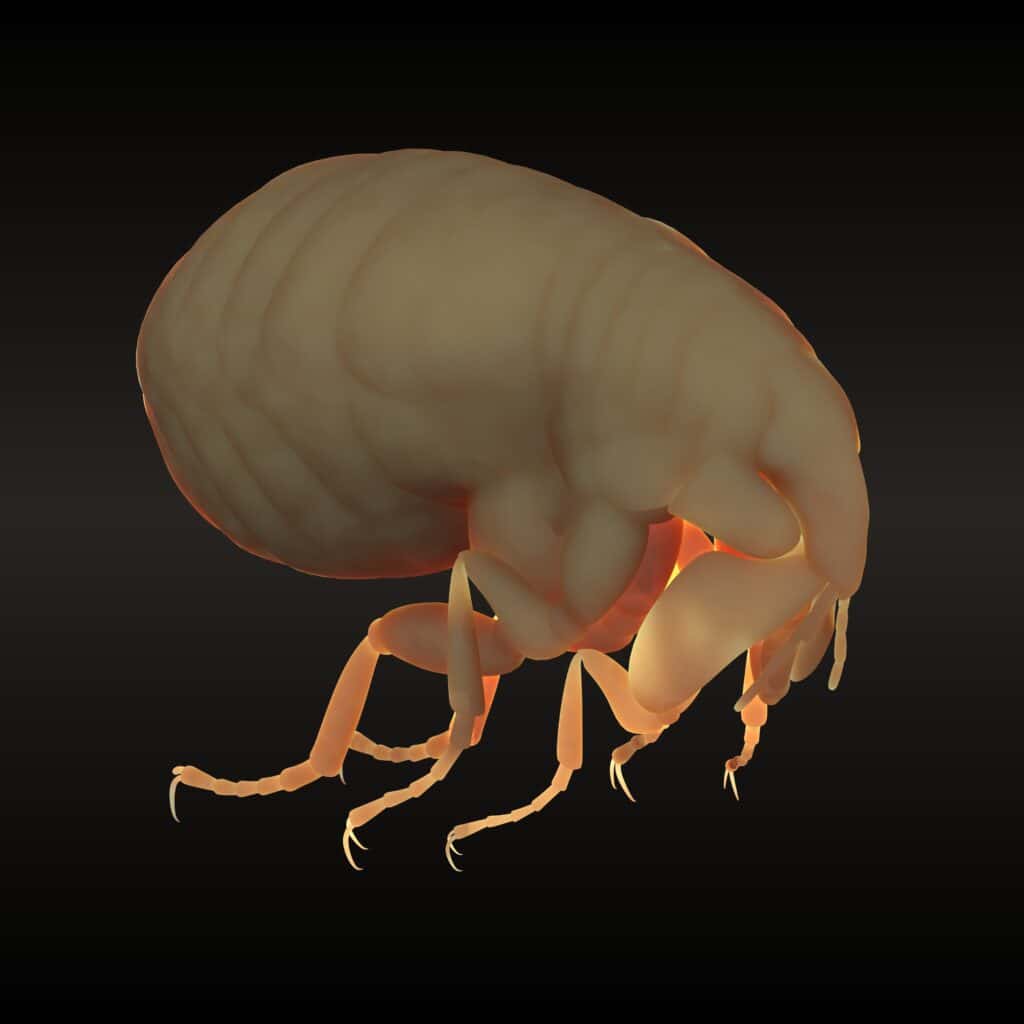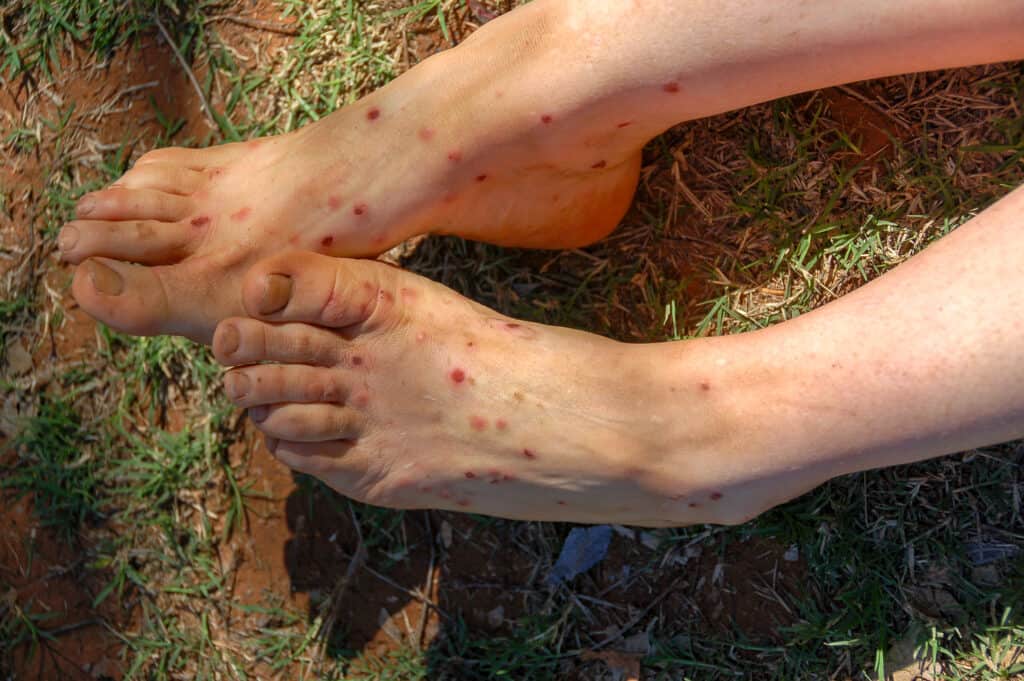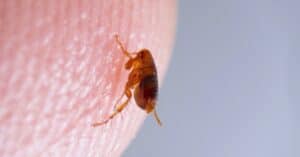Chigoe fleas, (Tunga penetrans), which are commonly called sand fleas, are the smallest known flea in the world. These tiny parasitic insects rarely grow larger than 1mm (0.04 inch) and have large heads compared to the rest of their body. They live 2-3 cm (0.08 -0.12 inch) underneath the sand and thrive in warm and wet tropical climates. Keep reading to learn more bout this biting insect and what do do if you fall victim to it’s painful, and possibly dangerous bite.

Chigoe fleas rarely grow larger than 1mm (0.04 inch) and have large heads compared to the rest of their body.
©3drenderings/Shutterstock.com
Can sand flea bites make you sick?
Chigoe flea bites can make you sick. Chigoe flea bites cause swelling, blistering and discomfort. Female chigoe fleas don’t just bite, they also burrow underneath the skin of their hosts, feeding on blood and producing / laying eggs. Once she has laid her eggs, which fall to the ground, the female sand flea dies which may result in minor skin irritation, or the skin infection tungiasis. While tungiasis isn’t deadly on its own, it can lead to fatal secondary infections like necrosis and gangrene.
A female sand flea can stay burrowed beneath the skin for 4 to 6 weeks before laying her eggs and dying. This is the primary reason sand flea bites are dangerous, thanks to the female sand flea’s rotting corpse. As if one bite weren’t bad enough, it’s possible to experience multiple sand flea bites and infections simultaneously.

A sand flea that has been removed from her host.
©https://upload.wikimedia.org/wikipedia/commons/5/56/Bicho-de-p%C3%A9_2.jpg – License
Do sand fleas stay in your skin?
Female sand fleas burrow into their host’s skin and don’t leave. Females require a near constant supply of blood from their hosts to produce eggs. The more blood they drink, the more eggs they produce. Once she has laid her eggs, the female sand flea dies in short order, and is generally shed by the host’s skin. However, if the carcass remains embedded in the host, infections may result.
How long does it take for sand flea bites to show up?
Sand flea bites start as small red bumps. They are easy to mistake for other insect bites, but unlike other insect bites which get better with time, sand flea bites get worse. Up to two weeks after she has burrowed into her host, the sand flea is getting plump with her eggs. Her growth is what creates the discomfort. Sand fleas usually bite about the feet and ankles, as these parts are easily and readily accessible on beaches where chigoe fleas live and folks tend to go barefoot.

Sand fleas usually bite about the feet and ankles, as these parts are easily and readily accessible on beaches where chigoe fleas live and folks tend to go barefoot.
©Andrew Atkinson/Shutterstock.com
How do you get rid of sand fleas on your skin?
To eliminate the chances of contracting tungiasis, it’s important to see a medical professional. To minimize your chances of becoming infected, the medical professional will remove the carcasses from beneath your skin, usually with sterile tweezers. Other methods of removal include suffocating and freezing.
Once the sand fleas are removed, your doctor will treat the skin infection, cleaning and bandaging the wound to prevent a secondary infection. Antibiotics may be prescribed.
Wearing shoes while walking on beaches with sand flea infestations is the most effective way of preventing sand fleas from nipping at you toes. While it’s possible for sand fleas to bite other parts of your body, it’s not likely. Use beach chairs and beach towels to keep exposed flesh off of the sand.
How do you know if you have tungiasis?
Tungiasis is a serious skin infection that requires medical attention to eliminate the possibility of secondary infections. The most common symptoms of tungiasis are pain and itching. Left untreated tungiasis can result in disfigurement, and in severe cases, death. Left untreated, tungiasis can develop into the secondary infections post-streptococcal glomerulonephritis and tetanus.
Wearing shoes and keeping exposed flesh off of the sand will prevent most sand flea bites. However, if you find yourself with itchy red bumps on your feet after a trip to the beach, a visit to the doctor might be in order.
Up Next:
- The Different Ways Dogs Get Fleas (And How to Get Rid of Them)
- Fleas vs. Ticks: What Are Their Differences?
- Do Fleas Die in the Winter?
The photo featured at the top of this post is © 3drenderings/Shutterstock.com
Sources
- who.int, Available here: https://www.who.int/news-room/fact-sheets/detail/tungiasis#:~:text=Tungiasis%20is%20caused%20by%20female,highest%20burden%20of%20the%20disease.
Thank you for reading! Have some feedback for us? Contact the AZ Animals editorial team.






